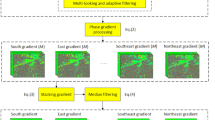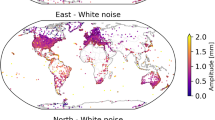Abstract
All-sky meteor radars are primarily used for meteor observations. This paper reports the first observations of ionospheric E-region field-aligned irregularities (FAIs) from a conventional all-sky meteor radar located at Wuhan (31°N, 114°E) for the period of March–June 2018. E-region FAI echoes evident in range-time intensity (RTI) maps show quasiperiodic striations with positive and negative slopes, which are consistent with multiple FAI structures moving across the wide beam of the meteor radar. A statistical analysis shows that out of a total of 111 d, there are 73 d with E-region FAI echoes detected by the meteor radar. The FAI events correspond well with the presence of sporadic-E layers which provide the necessary plasma density gradient for the development of gradient drift instability producing FAIs. The results demonstrate the capability of conventional meteor radars to make simultaneous routine observations of meteors and ionospheric E-region FAIs through incorporating RTI and spectral analysis into the online realtime data processing. Meteor radar observations could potentially address the limitations of ionospheric radars, which cannot provide simultaneous measurements of neutral winds and irregularity structures, and thereby contribute to better understanding of the dynamical processes producing E-region irregularities.
Similar content being viewed by others
References
Hysell D L, Burcham J D. The 30-MHz radar interferometer studies of midlatitude E region irregularities. J Geophys Res, 2000, 105: 12797–12812
Lu F, Farley D T, Swartz W E. Spread in aspect angles of equatorial E region irregularities. J Geophys Res, 2008, 113: A11309
Yamamoto M, Fukao S, Woodman R F, et al. Mid-latitude E region field-aligned irregularities observed with the MU radar. J Geophys Res, 1991, 96: 15943–15949
Kagan L M, Kelley M C. A wind-driven gradient drift mechanism for mid-latitude E-region ionospheric irregularities. Geophys Res Lett, 1998, 25: 4141–4144
Chau J L, Woodman R F. Low-latitude quasiperiodic echoes observed with the Piura VHF Radar in the E region. Geophys Res Lett, 1999, 26: 2167–2170
Chu Y H, Wang C Y. An evidence of beam broadening effect dominating Doppler spectra of field-aligned irregularities in sporadic E region made with the Chung-Li radar. J Geophys Res, 2005, 110: A09305
Venkateswara Rao N, Patra A K, Rao S V B. Some new aspects of low-latitude E-region QP echoes revealed by Gadanki radar: Are they due to Kelvin-Helmholtz instability or gravity waves? J Geophys Res, 2008, 113: A03309
Hocking W K, Thayaparan T, Jones J. Meteor decay times and their use in determining a diagnostic mesospheric Temperature-pressure parameter: Methodology and one year of data. Geophys Res Lett, 1997, 24: 2977–2980
Holdsworth D A, Reid I M, Cervera M A. Buckland park all-sky interferometric meteor radar. Radio Sci, 2004, 39: RS5009
Reid I M. MF and HF radar techniques for investigating the dynamics and structure of the 50 to 110 km height region: A review. Prog Earth Planet Sci, 2015, 2: 33
Jones J, Jones W. Meteor radiant activity mapping using single-station radar observations. Mon Not R Astron Soc, 2006, 367: 1050–1056
Dou X K, Xue X H, Li T, et al. Possible relations between meteors, enhanced electron density layers, and sporadic sodium layers. J Geophys Res, 2010, 115: A06311
Li G, Ning B, Hu L, et al. A comparison of lower thermospheric winds derived from range spread and specular meteor trail echoes. J Geophys Res, 2012, 117: A03310
Younger J P, Reid I M, Li G, et al. Observations of the new came-lopardalids meteor shower using a 38.9 MHz radar at Mohe, China. Icarus, 2015, 253: 25–30
Lee C, Kim J H, Jee G, et al. New method of estimating temperatures near the mesopause region using meteor radar observations. Geophys Res Lett, 2016, 43: 10580–10585
Liu L, Liu H, Chen Y, et al. Variations of the meteor echo heights at Beijing and Mohe, China. J Geophys Res Space Phys, 2017, 122: 1117–1127
Gong Y, Li C, Ma Z, et al. Study of the quasi-5-day wave in the MLT region by a meteor radar chain. J Geophys Res Atmosph, 2018, 123: 9474–9487
Yi W, Reid I M, Xue X, et al. High- and middle-latitude neutral mesospheric density response to geomagnetic storms. Geophys Res Lett, 2018, 45: 436–444
Ning B Q, Hu L H, Li G Z, et al. The first time observations of low-latitude ionospheric irregularities by VHF radar in Hainan. Sci China Tech Sci, 2012, 55: 1189–1197
Li G, Ning B, Hu L, et al. Observations on the field-aligned irregularities using Sanya VHF radar: 2 low latitude ionospheric E-region quasi-periodic echoes in the East Asian sector. Chin J Geophys, 2013, 56: 2141–2151
Li G Z, Ning B Q, Hu L H. Interferometry observations of low-latitude E-region irregularity patches using the Sanya VHF radar. Sci China Tech Sci, 2014, 57: 1552–1561
Li G Z, Ning B Q, Li A, et al. First results of optical meteor and meteor trail irregularity from simultaneous Sanya radar and video observations. Earth Planet Phys, 2018, 2: 15–21
Li G, Ning B, Chu Y H, et al. Structural evolution of long-duration meteor trail irregularities driven by neutral wind. J Geophys Res Space Phys, 2014, 119: 10,348–10,357
Zhou C, Liu Y, Tang Q, et al. Investigation on the occurrence of mid-latitude E-region irregularity by Wuhan VHF radar and its relationship with sporadic E layer. IEEE Trans Geosci Remote Sens, 2018, 56: 7207–7216
Tsunoda R T, Fukao S, Yamamoto M. On the origin of quasi-periodic radar backscatter from midlatitude sporadic E. Radio Sci, 1994, 29: 349–365
Larsen M F. A shear instability seeding mechanism for quasiperiodic radar echoes. J Geophys Res, 2000, 105: 24931–24940
Ogawa T, Takahashi O, Otsuka Y, et al. Simultaneous middle and upper atmosphere radar and ionospheric sounder observations of midlatitude E region irregularities and sporadic E layer. J Geophys Res, 2002, 107: 1275
Patra A K, Sripathi S, Sivakumar V, et al. Statistical characteristics of VHF radar observations of low latitude E-region field-aligned irregularities over Gadanki. J Atmos Sol-Terrestrial Phys, 2004, 66: 1615–1626
Xie H Y, Ning B Q, Zhao X K, et al. Case study of simultaneous observations of sporadic sodium layer, E-region field-aligned irregularities and sporadic E layer at low latitude of China. Adv Space Res, 2017, 59: 1559–1567
Yu Y, Wan W, Ning B, et al. Tidal wind mapping from observations of a meteor radar chain in December 2011. J Geophys Res Space Phys, 2013, 118: 2321–2332
Xue X H, Dou X K, Lei J, et al. Lower thermospheric-enhanced sodium layers observed at low latitude and possible formation: Case studies. J Geophys Res Space Phys, 2013, 118: 2409–2418
Haldoupis C. Midlatitude sporadic E. A typical paradigm of atmosphere-ionosphere coupling. Space Sci Rev, 2012, 168: 441–461
Haldoupis C, Schlegel K. Characteristics of midlatitude coherent backscatter from the ionospheric E region obtained with sporadic E scatter experiment. J Geophys Res, 1996, 101: 13387–13397
Shalimov S, Haldoupis C, Schlegel K. Large polarization electric fields associated with midlatitude sporadic E. J Geophys Res, 1998, 103: 11617–11625
Author information
Authors and Affiliations
Corresponding author
Rights and permissions
About this article
Cite this article
Xie, H., Li, G., Ning, B. et al. The possibility of using all-sky meteor radar to observe ionospheric E-region field-aligned irregularities. Sci. China Technol. Sci. 62, 1431–1437 (2019). https://doi.org/10.1007/s11431-018-9418-5
Received:
Accepted:
Published:
Issue Date:
DOI: https://doi.org/10.1007/s11431-018-9418-5




